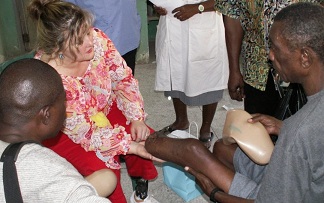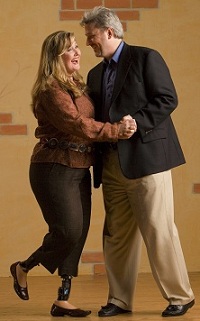“You can’t play the piano with clenched fists,” says Peter Rosenberger, whose rage still flares up unexpectedly after 33 years of caring for his wife.
“We caregivers often are on the edge of rage, so it’s important for us to find something to lose ourselves in. We all can do something, so do it. If we don’t, we’ll shrivel up.” A music major in college with a youthful dream of making it professionally, Peter as husband and caregiver loses himself today in his piano.
“I didn’t get the chance to evolve into something…to take on my adult identity” before marrying Gracie, Peter says. That was in 1986, when they were tender twenty-somethings. He’s been caring for Gracie ever since. “By any conventional sense we had no business getting married. I even doubt her doctors then understood the lifelong implications of her injuries.”
My blog has shared the stories of many caregivers, most of them caring for loved ones living with Alzheimer’s or another form of dementia. Not Gracie, though, who’s a double amputee with medical issues stemming from a horrific car wreck in 1983, when she was 17. One November afternoon, after several sleepless nights studying, she drove alone from Nashville to Memphis along I-40 and fell asleep at the wheel before slamming into a concrete abutment.
“The only memory I have of the wreck was seeing both of my legs pushed over my right shoulder,” Gracie wrote in a post on WebMD. “The damage was catastrophic: My ankles were pulverized; every bone from the waist down was broken—one surgeon counted nearly 200 fractures; and several of my organs were damaged.”
Gracie has had two leg amputations below the knee, the first in 1991 after Parker was born and the second in 1995 after Grayson’s birth. To date, she’s undergone more than 80 operations and 150 smaller procedures while running through seven insurance companies and more than $10 million in medical bills. “Her doctor,” according to Peter, “says another operation could be her death.”
Gracie’s car in 1983
Peter didn’t understand the magnitude of Gracie’s problems until three years after their wedding. He describes this scene from 1989 in his book Hope for the Caregiver: It was the middle of the night and he was sitting outside Gracie’s hospital room after she experienced her first grand mal seizure. (She’s had four or five since.) He was staring at a pile of medical documents that were staring back at him.
“Not even her family had read what I now studied,” Peter writes. “Poring through doctors’ notes, I realized Gracie’s accident was unlike anything I imagined…I hung my head in grief and hopelessness. For the first time in my life, I felt a despair that would hover over me for the next dozen years—and one that still requires my vigilance to guard against.”
“Reading until dawn,” he continues, “I closed the massive folder and sadly noted that the cover stated ‘Volume 4 of 4’ … The events of that night forever altered me, along with the way I view life, hospitals, doctors, other people, my wife, and even God. Although immature, I was devoted. My sincere desire to care for this extraordinary woman led me to begin this journey. I never imagined, however, that the road would contain such suffering, loss, heartache, self-sacrifice, failure, and love.”
“That night in the hospital corridor, my heart sunk as I stared at a future full of relentless challenges with no expiration date. I felt trapped, but also understood the need for me to stay alive and healthy.”
“A difficult place for a 26-year-old man.”
And a difficult place even today for this 56-year-old man.
Richard Rohr, a noted Franciscan friar and priest, wrote a book titled Falling Upward: A Spirituality of the Two Halves of Life, which is echoed in journalist David Brooks’s current title, The Second Mountain. The underlying theme of each is that great loss or failure can drive us in one of two directions: collapsing into fear and despair, even cynicism, or rising into a fullness of life, into a joy that’s been seasoned by such loss.
Gracie and Peter chose a path of seasoned hope and joy.
They have turned their continuous pain inside out. Each with their own style and talent is showing a way forward to those suffering from unimaginable pain and to fellow caregivers of almost any stripe.
For her part Gracie, who Peter describes as “a force of nature,” sings and shares her story wherever invited. And she and Peter established a foundation, Standing with Hope, to provide prosthetic limbs to fellow amputees in developing countries. They launched in Ghana, West Africa.
Gracie in Ghana
“Music has always been the great uniter for us,” says Peter. “We lose ourselves in our music; it gives us moments of complete rest. When Gracie sings it’s at a soul level, it’s something extraordinary.”
In this song and video co-written by Peter, I Can Only Hold You Now, Gracie is singing and he’s on the piano.
Meanwhile, Peter has an uncanny knack of connecting with caregivers across a broad spectrum of issues. Or, as his buddy Jeff Foxworthy, the comedian, told Peter, “You have a gift to put very complex things on the bottom shelf for people.” Peter’s voice arises from a soul tempered by crisis upon crisis and from a spirit salted with humor and music.
“It took a long, long time and a lot of mistakes to get my voice. But now I can speak fluent Caregiving,” he tells me today with no hint of arrogance. “I now speak with great clarity and great specificity to my caregivers…Broad brush counseling does a caregiver no good” once they’ve been tossed into a ditch of volatile, conflicting emotions.
Peter launched a weekly radio program in 2013, “Hope for the Caregiver.” It’s broadcast weekly on WLAC 1510-AM in Nashville and is syndicated today on more than 200 stations. He bills it as “The Nation’s #1 Radio Show for Family Caregivers.” You can stream his program on his website or catch it on his Facebook page.
“Armed only with a relentless persistence, a goofy sense of humor, a few ‘smarts,’ and a degree in music…I somehow keep the plates spinning. When it comes to ‘wanna-be’ stand-up comedians who play the piano and take care of a disabled wife for decades, I’m the best there is.”
I was Peter’s guest in early April, sharing our family’s story with his listeners.
Peter writes in his book, “After decades of acting like a superhero every time a medical crisis pops up (often daily), I’m learning that my role is to love my wife…do the best I can…and grow as a healthy individual to the best of my abilities.” Peter’s style is direct and simple. Of his book’s 40 chapters, few run over three pages. Yet the book is anything but simplistic, for a weathered voice of authority runs deep through its veins. He had to grow up fast.
“My book is written to my 22-year-old self. I was clueless. I’m speaking to that young guy…That night in the hospital so long ago, I wouldn’t have been able to process a ‘how-to’ manual that required even more of the precious resources I spent every day.”
“I needed (a guide that’s) simple, attainable, practical, and able to do ‘right now’…What does that look like? It looks like implementing easy-to-accomplish, consistent steps to address the six major ‘HELP ME’ impact areas affected by caregiving: Health. Emotions. Lifestyle. Profession. Money. Endurance.”
“Caregivers suffer from a loss of independence, a loss of identity, and isolation…I’ve found it wise to listen to people with scars. Their experience can help me avoid the injuries they’ve endured.”
“Sadly, too many caregivers don’t know how to create a sustainable care-structure for themselves…Help is available, but caregivers must be willing to accept that help while tuning out the fear…that can consume us during highly stressful moments.”
Peter wraps up our conversation: “Amputations and orthopedics are not the challenges I have to deal with. Gracie is hurt at multiple levels. What do 35 years of anesthesia and painkillers do to a person? The reason I’m qualified (to talk to caregivers) is not because she’s a double amputee. It’s because of the pain and behavioral issues, stuff that keeps coming at you.”
“My hardest thing as a caregiver is to know what is mine and what is not mine, and too often I don’t. I’ve got to realize real quick when I’ve made a mess. Gracie and I have very little margin for error.”
Thank you, Peter, for sharing your time and insights with us, and for sharing your story and Gracie’s. I wish a book like yours was around in 1997, when my wife Martha was diagnosed with early onset Alzheimer’s at age 50.
~~~~~~~~~~~~~~~~~~~
On occasion, I give a book away. This is one of those occasions. In fact, I have three signed copies of Hope for the Caregiver to give away. If you’d like to put your name into the hat for one of these, here’s how:
Anyone is eligible, whether you subscribe to my newsletter or not. Simply send an email to carlen@carlenmaddux.com between this Wednesday, June 5, and Friday, June 7, by 12:00 Midnight EDT. Indicate that you would like to be included in the drawing and put in the subject line: BOOK GIVEAWAY.
Three persons will be selected at random from those entering. I’ll send you a congratulatory email on Saturday, June 8. You will have 48 hours to respond to my email. If I don’t hear back from you by then, someone else will be selected at random.
For more details, click Book Giveaway.
Thank you,
Carlen
www.carlenmaddux.com
carlen@carlenmaddux.com
PS1 As usual, feel free to forward this post to your friends and family. If you’d like to sign up for my blog, there’s no charge; just click here.
PS2 June is Alzheimer’s & Brain Awareness Month. An effective and inexpensive way to support the end of this disease is to buy several sheets of Alzheimer’s first-class stamps. By now you know that the net proceeds of this 65-cent stamp go to the National Institutes of Health for Alzheimer’s research. As of April, over 6.5-million stamps have been sold, raising $890,000. Join me and thousands of others to Help Stamp Out Alzheimer’s.
PS3 My book, A Path Revealed: How Hope, Love, and Joy Found Us Deep in a Maze Called Alzheimer’s, can be ordered from any bookstore or found on Amazon. I share our family’s 17-year odyssey of living with this disease. My high-energy wife Martha was 50 when diagnosed; I was 52. Our children were in high school and college. But Alzheimer’s is not the focus of our story; it’s the context. The focus is the spiritual odyssey that unfolded before us, sometimes in strange and surprising ways, other times in the most ordinary of ways.








